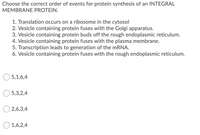
Concept explainers

Gene expression is the process by which information from a gene is used in the synthesis of a functional gene product that enables it to produce end products, protein or non-coding RNA, and ultimately affect a phenotype, as the final effect.
Protein synthesis can be divided broadly into two phases - transcription and translation. During transcription, a section of DNA encoding a protein, known as a gene, is converted into a template molecule called messenger RNA (mRNA). In eukaryotes, this mRNA is initially produced in a premature form (pre-mRNA) which undergoes post-transcriptional modifications to produce mature mRNA. Mature mRNA is exported from the cell nucleus via nuclear pores to the cytoplasm of the cell for translation to occur. During translation, the mRNA is read by ribosomes which use the nucleotide sequence of the mRNA to determine the sequence of amino acids. Ribosomes form polypeptide bond between two amino acids.
The pathway from the ER to the cell surface involves many sorting steps, which continually select membrane and soluble lumenal proteins for packaging and transport—in vesicles or organelle fragments that bud from the ER and Golgi apparatus.To initiate their journey along the biosynthetic-secretory pathway, proteins that have entered the ER and are destined for the Golgi apparatus.These transport vesicles bud from specialized regions of the ER called ER exit sites, whose membrane lacks bound ribosome. The exit signals that direct proteins out of the ER for transport to the Golgibody.Each Golgi stack has two distinct faces: a cis face (or entry face) and a trans face (or exit face). Proteins and lipids enter the cis face of golgi in vesicular tubular clusters arriving from the ER and exit from the trans face of golgi bound for the cell surface(Plasma membrane) or another compartment.
Trending nowThis is a popular solution!
Step by stepSolved in 2 steps

- please help fill in this CER :)arrow_forward1. Match the cell structures in column A with their functions in column B. Column A 1. 2. 3. 4. 5. Centrioles Chromatin Cytoplasm Cytoskeleton Rough Endoplasmic Reticulum (ER) 6. 7. 8. 9. 10. 11. Peroxisomes 12. Plasma membrane Golgi apparatus Lysosomes Mitochondria Nucleolus Nucleus 13. Ribosomes Column B a. a selectively permeable barrier between the cell's intracellular and extracellular environments b. includes cellular organelles and cytosol c. contains the cell's genetic material (DNA) d. synthesizes rRNA and assembles ribosomes in the nucleus e. genetic material within the nucleus; consists of uncoiled chromosomes and associated proteins f. synthesizes new proteins destined for the plasma membrane, lysosomes, or secretion from the cell g. sites of protein synthesis; may be bound to the ER ("bound") or found within the cytoplasm ("free") h. a stack of flattened membranes that are the site where proteins from the ER are modified, packaged, and sorted for delivery to other…arrow_forwardWhich of the following can be found attached to the mosaic cell membrane? I. GLUT1 II. cAMP III. Glycoproteins IV. Lipoproteins V. Integral proteinsarrow_forward
- 5) A boy with a congenital skin disease has rings of creases on his arms and legs as well as unusual facial features, intellectual disability, slow growth, and a cleft palate. His condition, termed a "tubulinopathy" is caused by a mutation in the gene TUBB. Based on what we learned about cell structure and organelle function, what part of the cell would you predict is affected by this condition?arrow_forwardChoose all true statements about the difference between translation at free ribosomes versus bound ribosomes. - Free ribosomes are made in cytoplasm, whereas bound ribosomes are made in the nucleus. - Free ribosomes produce proteins in the cytosol, whereas bound ribosomes produce proteins inside the nucleus. - Bound ribosomes produce proteins that are exported from the cell, whereas free ribosomes make proteins for the nucleus.arrow_forwardHepatitis C viral infection causes the Golgi apparatus in cells to degrade. Which of the following would be a likely outcome for someone infected with hepatitis C? A. Removal of foreign substances and worn-out cell components would be prevented B. Synthesized proteins would be packaged into transport vesicles at a slower rate C. Ribosomal function would decrease D. Secretory proteins would be prevented from being secretedarrow_forward
- Part 1: Membranes are critical to the structure and function of cells. Answer yes or no to identify which of the following cellular components are made of, or include, membranes: chromatin: ribosomes: nuclear envelope: central vacuoles: Part 2: Membrane fluidity, which allows fusion and pinching off of membranes, is critical to many cellular processes. Answer yes or no to to identify which of the following cellular processes rely directly on this property of membranes: transcription: translation: replication: protein secretion in eukaryotes:arrow_forwardCreate a table the organelles, the cytoplasm, their location and their function a. mitochondria b. ribosome c. golgi bodies d. lysosomes e. Nucleus f. cytoplasmarrow_forward
 Human Anatomy & Physiology (11th Edition)BiologyISBN:9780134580999Author:Elaine N. Marieb, Katja N. HoehnPublisher:PEARSON
Human Anatomy & Physiology (11th Edition)BiologyISBN:9780134580999Author:Elaine N. Marieb, Katja N. HoehnPublisher:PEARSON Biology 2eBiologyISBN:9781947172517Author:Matthew Douglas, Jung Choi, Mary Ann ClarkPublisher:OpenStax
Biology 2eBiologyISBN:9781947172517Author:Matthew Douglas, Jung Choi, Mary Ann ClarkPublisher:OpenStax Anatomy & PhysiologyBiologyISBN:9781259398629Author:McKinley, Michael P., O'loughlin, Valerie Dean, Bidle, Theresa StouterPublisher:Mcgraw Hill Education,
Anatomy & PhysiologyBiologyISBN:9781259398629Author:McKinley, Michael P., O'loughlin, Valerie Dean, Bidle, Theresa StouterPublisher:Mcgraw Hill Education, Molecular Biology of the Cell (Sixth Edition)BiologyISBN:9780815344322Author:Bruce Alberts, Alexander D. Johnson, Julian Lewis, David Morgan, Martin Raff, Keith Roberts, Peter WalterPublisher:W. W. Norton & Company
Molecular Biology of the Cell (Sixth Edition)BiologyISBN:9780815344322Author:Bruce Alberts, Alexander D. Johnson, Julian Lewis, David Morgan, Martin Raff, Keith Roberts, Peter WalterPublisher:W. W. Norton & Company Laboratory Manual For Human Anatomy & PhysiologyBiologyISBN:9781260159363Author:Martin, Terry R., Prentice-craver, CynthiaPublisher:McGraw-Hill Publishing Co.
Laboratory Manual For Human Anatomy & PhysiologyBiologyISBN:9781260159363Author:Martin, Terry R., Prentice-craver, CynthiaPublisher:McGraw-Hill Publishing Co. Inquiry Into Life (16th Edition)BiologyISBN:9781260231700Author:Sylvia S. Mader, Michael WindelspechtPublisher:McGraw Hill Education
Inquiry Into Life (16th Edition)BiologyISBN:9781260231700Author:Sylvia S. Mader, Michael WindelspechtPublisher:McGraw Hill Education





